Select statement is used to fetch data from one or more tables. It can use predicates like WHERE, GROUP BY, HAVING, and ORDER BY. The WHERE clause filters rows based on conditions, GROUP BY organizes rows into groups, HAVING applies conditions to groups, and ORDER BY sorts the results. Aggregate functions like COUNT, SUM, AVG, MAX, MIN perform calculations on multiple rows and return a single value.
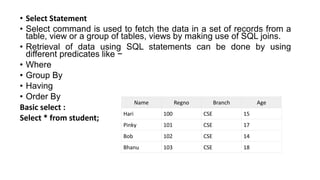
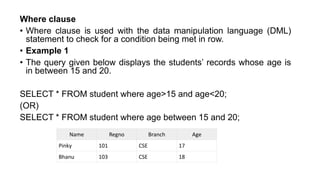
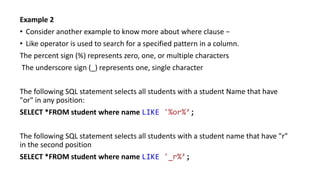
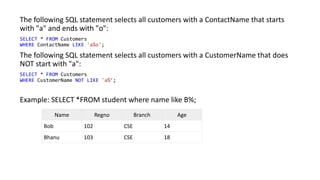
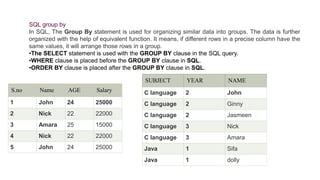

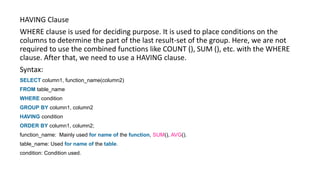


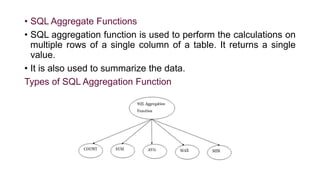
![COUNT FUNCTION
• COUNT function is used to Count the number of rows in a
database table. It can work on both numeric and non-numeric
data types.
• COUNT function uses the COUNT(*) that returns the count of
all the rows in a specified table. COUNT(*) considers duplicate
and Null.
Syntax:
COUNT(*)
or
COUNT( [ALL|DISTINCT] expression )](https://image.slidesharecdn.com/unit3-selectoptionsandaggregatefunctionsinsql1-231123025516-aa5b250f/85/Unit-3-Select-Options-and-Aggregate-Functions-in-SQL-1-pptx-11-320.jpg)

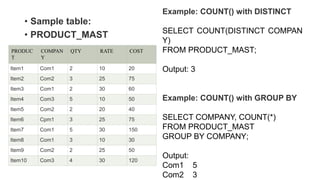

![2. SUM Function
• Sum function is used to calculate the sum of all selected
columns. It works on numeric fields only.
Syntax
SUM()
or
SUM( [ALL|DISTINCT] expression )
Example: SUM()
SELECT SUM(COST)
FROM PRODUCT_MAST;
Output: 670
PROD
UCT
COM
PANY
QTY RATE COST
Item1 Com1 2 10 20
Item2 Com2 3 25 75
Item3 Com1 2 30 60
Item4 Com3 5 10 50
Item5 Com2 2 20 40
Item6 Cpm1 3 25 75
Item7 Com1 5 30 150
Item8 Com1 3 10 30
Item9 Com2 2 25 50
Item10 Com3 4 30 120](https://image.slidesharecdn.com/unit3-selectoptionsandaggregatefunctionsinsql1-231123025516-aa5b250f/85/Unit-3-Select-Options-and-Aggregate-Functions-in-SQL-1-pptx-15-320.jpg)

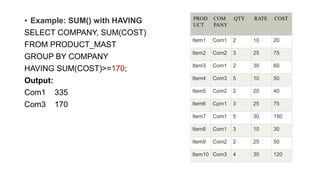
![• 3. AVG function
• The AVG function is used to calculate the average value of the
numeric type. AVG function returns the average of all non-Null
values.
• Syntax
AVG()
or
AVG( [ALL|DISTINCT] expression )
Example:
SELECT AVG(COST)
FROM PRODUCT_MAST;
Output: 67.00](https://image.slidesharecdn.com/unit3-selectoptionsandaggregatefunctionsinsql1-231123025516-aa5b250f/85/Unit-3-Select-Options-and-Aggregate-Functions-in-SQL-1-pptx-18-320.jpg)
![4. MAX Function
• The MAX function is used to find the maximum value of a certain
column. This function determines the largest value of all selected
values of a column.
• Syntax
MAX()
or
MAX( [ALL|DISTINCT] expression )
Example:
SELECT MAX(RATE)
FROM PRODUCT_MAST;
Output:30](https://image.slidesharecdn.com/unit3-selectoptionsandaggregatefunctionsinsql1-231123025516-aa5b250f/85/Unit-3-Select-Options-and-Aggregate-Functions-in-SQL-1-pptx-19-320.jpg)
![5. MIN Function
• MIN function is used to find the minimum value of a certain column.
This function determines the smallest value of all selected values of
a column.
• Syntax
MIN()
or
MIN( [ALL|DISTINCT] expression )
• Example:
SELECT MIN(RATE)
FROM PRODUCT_MAST;
Output: 10](https://image.slidesharecdn.com/unit3-selectoptionsandaggregatefunctionsinsql1-231123025516-aa5b250f/85/Unit-3-Select-Options-and-Aggregate-Functions-in-SQL-1-pptx-20-320.jpg)